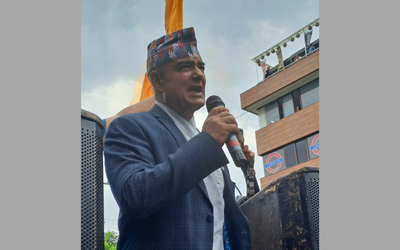There were a few very important foreigners who contributed to Nepali history when Nepal itself was not much known to the world. They included Colonel William Kirkpatrick, Francis Buchanan Hamilton, Brian Hodgson, H. A. Oldfield, Daniel Wright, Perceval Landon and, of course, Sylvain Levi. All except Lévi (1863 – 1935) were Englishmen who were connected with the East India Company or the British government, or both.
Sylvain Lévi was a French scholar. He visited Nepal in the last days of Prime Minister Bir Shumsher. He was an orientalist with good knowledge of India, Tibet and China. His knowledge of Sanskrit was commendable. His book Théâtre Indien was an important work on the subject. Lévi also conducted some of the earliest analysis of Tokharin fragments discovered in Western China. He is known in Nepal as the author of three volume Le Népal: Étude historique d’un royaume hindou (Paris: Ernest Deroux, 1905, 1908). At the time it was published, it was the first attempt to portray a full scale history of Nepal based on thorough analysis of all available sources.
Lévi starts his book with a very lucid introduction of the Kingdom of Nepal. He then describes Nepal valley, the people residing in Nepal, their economic, political and legal institutions, and details about local gods and goddesses, and the Hindu and Buddhist religions as practiced in Nepal. His analysis of religious and cultural practices along with principal festivals shows how intensely he must have studied these aspects of Nepal’s social life during his short stay in Nepal. Apart from the study of King Nanya Dev, he has also described the history of Bhadgaon, Kathmandu and Patan – the three major principalities of Nepal before the country was unified (or re-unified). His last chapter is the study of King Prithvi Narayan Shah and the dynasty of Gorkha Kings.
Sylvain Lévi considers Nepal, and the Kathmandu valley in particular, as India in the making. In other words, in his opinion, Nepal’s medieval and modern history repeats the genesis of India. Just as in other parts of Asia, in Nepal, too, it is Buddhism that first contributed to ‘civilizing’ a multitude of tribal and regional cultures in Nepal, the final cultural ‘annexation’ of which was then achieved by Hinduism. Lévi commented that the traditions of Hinduism and Buddhism are so closely interwoven in Nepal that it made no sense to see Nepalese god as either Hindu or Buddhist. He also shows the concern that there were a few learned scholars here and there in Nepal, but the torch of ancient knowledge was dying out.
Dilli Raman Regmi, a Nepalese scholar and politician, who familiarized Nepalese people about Le Népal by his writing in English maintained that Sylvain Lévi’s contribution to the knowledge of Nepalese history was not less than the contribution of Pandit Dr Bhagwanlal Indraji, who published the first collection of twenty three Nepalese inscriptions in 1888. More important than this was the fact that out of them fifteen collections were of ancient Nepal.
Levi was fortunate enough to be allowed by the Nepalese administration to stay in Nepal longer than any other scholar. While in Nepal he used his time and energy to collect rumblings of inscriptions available to him. He also obtained chronicles compiled by efforts of scholars of the early 19th century based on both Buddhist and Brahmmanical traditions, which he used along with the inscriptions, to write the history of Nepal. D. R. Regmi noted that he was not able to use as much Nepalese sources as he used Tibetan and Chinese sources. For example, he knew of only 17 Sanskrit inscriptions of the Licchavi period of Nepal, for instance, while today there are over 200 such inscriptions known.
One can also find some inaccurate information in Le Népal. For example, according to Sylvain Lévi, the Newar people had migrated to this country from regions north of the Himalayas, a view conflicting with the indigenous belief that the Newars have moved to the Himalayas from an earlier homeland in Southern India. One can see that there is no concrete evidence in support of either of these theories. No doubt immigrants from India as well as from Tibet have at times exerted a considerable influence on Newar culture, and some of them have ultimately been absorbed into Newar society, but there is every reason to believe that the bulk of the Newar people has been settled in the Nepal valley since prehistoric times.
To a modern reader, Sylvain Lévi’s Étude historique d’un royaume hindou may appear outdated in some ways. Nevertheless, it was unmatched as a book which had a wealth of information and analysis when it was published. Dilli Raj Upreti, the Nepalese diplomat who rendered Levi’s Le Népal into Nepali in 2005 must be thanked for his effort to make it accessible to all Nepalese people.
